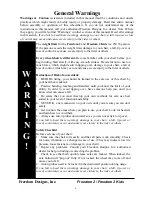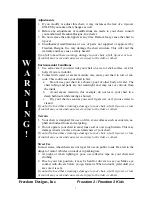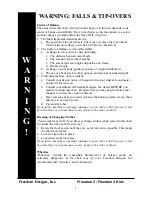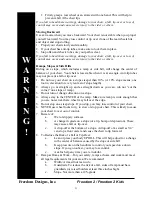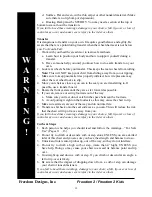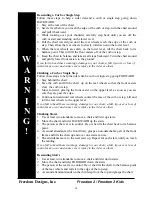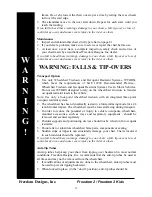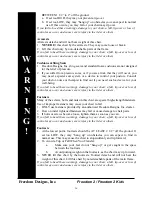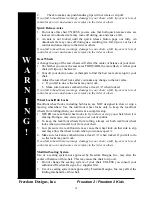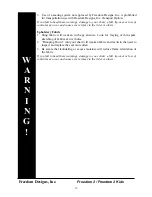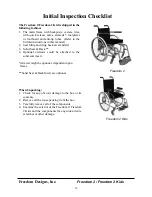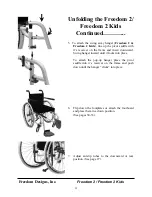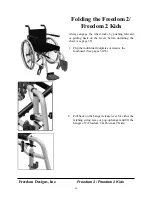
11
Freedom Designs, Inc.
Freedom 2 / Freedom 2 Kids
WARNING:
WARNING:
f. Firmly grasp a rear wheel or an armrest with one hand. This will help to
prevent a fall if the chair tips.
If you fail to heed these warnings, damage to your chair, a fall, tip-over or loss of
control may occur and cause severe injury to the rider or others.
Moving Backward
Use extra care when you move backward. Your chair is not stable when you propel
yourself rearward. You may lose control or tip over if one of the rear wheels hits
and object and stops rolling.
1. Propel your chair slowly and smoothly.
2. If your chair has anti-tip tubes, make sure to lock them in place.
3. Stop often and check to be sure your path is clear.
If you fail to heed these warnings, damage to your chair, a fall, tip-over or loss of
control may occur and cause severe injury to the rider or others.
Ramps, Slopes & Side Hills
Riding on a slope, which includes a ramp or side hill, will change the center of
balance of your chair. Your chair is less stable when it is at an angle. Anti-tip tubes
may not prevent a fall or tip-over.
1. Do not use your chair on a slope steeper than 10%. (A 10% slope means: one
foot in elevation for every ten feet of slope length).
2. Always go as straight up and as straight down as you can. (do not “cut the
corner” on a slope or ramp).
3. Do not turn or change direction on a slope.
4. Always stay in the CENTER of the ramp. Make sure ramp is wide enough that
you are not at risk that a wheel may fall over the edge.
5. Do not stop on a steep slope. If you stop, you may lose control of your chair.
6. NEVER use wheel locks to try to slow or stop your chair. This is likely to cause
your chair to veer out of control.
7. Beware of:
a.
Wet or slippery surfaces.
b.
A change in grade on a slope (or a lip, bump or depression). These
may cause a fall or tip-over.
c.
A drop-off at the bottom of a slope. A drop-off of as small as 3/4”
can stop a front caster and cause the chair to tip forward.
8. To Reduce the Risk of a Fall or Tip-Over:
a.
Lean or press your body UPHILL. This will help adjust for a change
in the center of balance caused by the slope or side hill.
b.
Keep pressure on the handrims to control your speed on a down
slope. If you go too fast, you may lose control.
c.
Ask for help any time you are in doubt.
9. Ramp at Home & Work—For your safety, ramps at home and work must meet
all legal requirements for your area. We recommend:
a.
Width: At least four feet wide.
b.
Guardrails. To reduce the risk of a fall, sides of ramp must have
guardrails (or raised borders at least three inches high).
c.
Slope. Not more than a 10% grade.
W
A
R
N
I
N
G
!
Summary of Contents for Freedom 2
Page 2: ......






